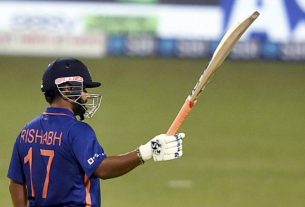Shared News
• Last updated on Tue, 19 Jun, 2018, 12:56 PM
Ambati Rayudu was dropped from India’s limited overs team for the forthcoming tour of England after failing to clear the endurance test. © Getty
The Yo-Yo test, the new benchmark for attaining fitness to play for Team India, has also become a source of heartbreak for many players who’ve failed to clear it since it was made mandatory. After Suresh Raina, Yuvraj Singh and Washington Sundar were dropped for falling below the ‘16.1’ score, the latest ‘victim’ of the BCCI’s ‘Yo-Yo’ policy was in-form batsman Ambati Rayudu, who was dropped from India’s limited overs team for the forthcoming tour of England, after failing to clear the endurance test.
Rayudu’s axing, coming close on the heels of Sanju Samson being removed from the India ‘A’ side for the tour of England for the same reason, has ushered in a debate on the logic of dropping players on the basis of just their failure to clear the ‘Yo-Yo test.’ While appreciating the stress on improving the fitness levels of the Indian team, former India batsman, coach and chief selector Sandeep Patil asks for some leniency while judging players’ careers.
“Like in Test cricket, where a player is given two innings to prove himself, even in the case of Yo-Yo tests, he should be given two chances. If a player isn’t able to clear the test, give him another crack at it a few hours later, or the next day. There could be many reasons why Ambati Rayudu failed the Yo-Yo test that day. A player may not be mentally there. You’re talking about the career of a player. He has performed well for the whole year in domestic cricket, and in half-an-hour, you’ll decide whether he’d go on the tour or not. You don’t drop players like this,” Patil told TOI.
Amogh Pandit, who was a trainer with the Mumbai team for 14 years, before heading the department of the MCA’s strength, conditioning and nutrition department for the last four years, laments the decision to judge players’ fitness on just one test. “If a sport requires multiple fitness components, how can you chuck someone out on the basis of just one fitness component. There’s no guarantee that one can’t pick up an injury after clearing a Yo-Yo test. You need to count mobility, flexibility, strength and power too. Secondly, a fast bowler requires explosiveness, power. A spinner needs endurance. A Yo-Yo test measures cardio-vascular endurance. It’s not fair to drop a pacer because of this factor. I need to see various components like power, strength to judge his fitness. A Yo-Yo test is one of the tests to measure a player’s fitness. You can’t judge a person’s fitness on just this test. It’s like a batsman keeps practising a cover drive, but doesn’t know how to play a sweep shot,” he says.
Pandit then further explains his reservations against the Yo-Yo being given too much importance. “If I keep doing bench press, I’ll lift more weight in a few weeks’ time, but will it help me become a better cricketer? You’ve to look for cricket-specific tests, like ‘run a three,’ which we used to do. From what it appears, only Yo-Yo is being considered as a mandatory test. Rayudu’s in great form now, but failed the Yo-Yo and was dropped. Next time, when he clears Yo-Yo, but is in bad form, will you select him?”
What do other celebrated cricket teams like Australia do? “They aren’t implementing the Yo-Yo tests, but they have a ‘2km time trial’ as their benchmark fitness test. The idea of a fitness test is to see if the player can go through a six-seven-hour cricket match without getting fatigued,” Pandit reveals.
Patil, who has also served as director of the NCA, states that only Yo-Yo tests aren’t considered while deciding the fitness, or lack of it, of the players.



